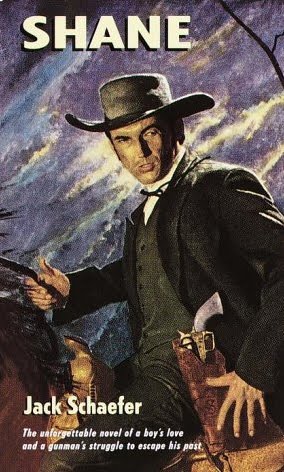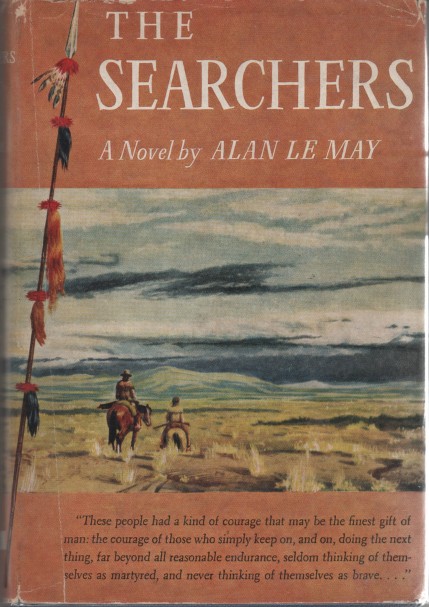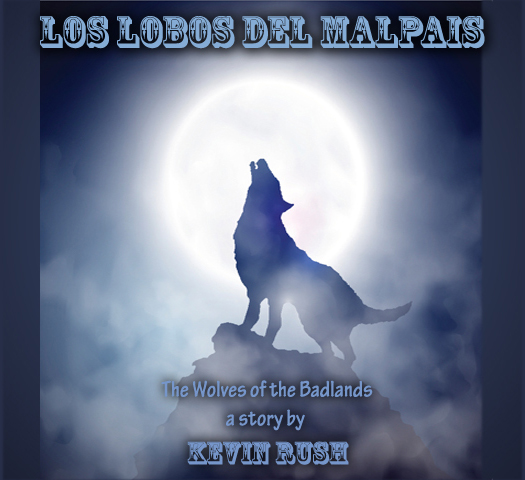Ladd and Wayne craft icons in Shane and The Searchers. By Kevin Rush.
The Western is the archetypal American story. Its roots go back at least to the early 19th century and James Fenimore Cooper’s Leatherstocking Tales. In those five novels, Cooper laid out the rules that future writers would assiduously follow: the unyielding land, the Noble Savage and his ruthless counterpart, and the frontiersman, whose identity is so closely tied to a changing landscape that once he tames the land, he finds he can no longer inhabit it. Drawing on existential struggles with nature and against our own human nature, Westerns gained popularity the world over. In Hollywood, they have made an indelible impact that has bled into other film genres as well. I’ve watched Western movies and TV shows all my life, but I’ve read very few Western novels. Today I look at two which served as source material for two of the greatest Western films ever made: Shane and The Searchers.
Shane: Mysterious stranger rights wrongs and moves on
Nominated for six Academy Awards, the classic 1953 film, starring Alan Ladd as the eponymous gunslinger, is thought by many to be a perfect western movie. This is largely thanks to Director George Stevens’ relentless tinkering in the editing room which delayed the film’s release for two years. Originally intended as a B picture, Shane benefited from Stevens’ meticulous, one might say obsessive, perfectionism, which ballooned the budget and forced the studio to promote the film as a major release. Thus, a classic was born.
An Oscar winner for cinematography in 1954, Shane is beautifully shot on location in Jackson Hole, Wyoming, in breath-taking color. The solid cast includes Van Heflin, Jean Arthur, Brandon De Wilde (who scored a Best Supporting Actor nomination for a performance given at the tender age of nine), Edgar Buchanan, Elisha Cook Jr., and Jack Palance (also nominated for Best Supporting Actor).

I tend to be more critical than most about the casting of Ladd. He might squint and set his jaw like Randolph Scott or Gary Cooper, but his stature was no more imposing than Mickey Rooney’s. In the book, Shane is described as a slender man, not tall like the boy’s father, played to perfection by Van Heflin. But neither was Shane a shrimp. Shane is a man whose intensity and lithe animal reflexes make up for his spare frame. He’s also described as dark haired, unlike the blondish Ladd. Physical dimensions aside, Ladd does capture the essence of Shane as rendered in the novel, so I’m not going to be too critical. I just think there were better choices, such as Montgomery Clift, who unfortunately wasn’t interested. Clift passed on the role, forcing Stevens to settle for Ladd, who exploited the opportunity to forge his signature role.
Stevens also had to coax Jean Arthur out of retirement. He had directed her in The More the Merrier (1943), for which Arthur received her only Academy Award nomination, for Best Actress. She agreed to play the mother, Marian, even though at fifty, she was well past the character’s age. That isn’t an issue for me. I’ve always enjoyed Jean Arthur, and she gives a fine performance, looking very much like a care-worn wife and mother of the Plains. Sadly, Arthur immediately went back into retirement, emerging only for an episode of Gunsmoke in 1965 and a short-lived 1966 TV program, The Jean Arthur Show.
I found the novel Shane in the YA section of my local public library, where it had sat, judging from the paperback binding, unread since its purchase. Appropriate shelving, since author Jack Schaefer dedicates the work:
To Carl
For my first son
My first book
The fact that it hadn’t been read strikes me as a sad. Although Schaefer’s novel doesn’t break any new ground—his hero is cut from the Natty Bumpo mold, hewn from the frontier and destined to move West once the evil forces are thwarted and the area becomes too civilized—the book is eminently readable.

The action sequences mix edge-of-the-seat suspense with abrupt and brutal violence that is vivid, but not gratuitous. The characters are well-drawn and multi-layered. It’s an engrossing, quick read. But should you bother, if you’ve seen Stevens’ film? I would say yes, because of the extra depth given the characters.
In true YA form, the narrator of Shane is a boy, named Bob Starrett, but called Joey in the movie. Well, that’s not quite accurate; the narrator is the mature Bob Starrett recalling the drama of his youth. Bob is an observant and imaginative lad, but there is much going on in the triangular relationship between the father, Joe, his wife, Marian, and Shane than exists in the movie, and much of it goes over the head of the juvenile witness. I don’t want to spoil anything, but let’s just say, its heavy stuff for a YA book.
My only complaint is that the elegiac descriptions of Shane are often over the top, beyond a boy’s hero worship. Reading certain passages, I was aware that Schaefer was consciously trying to create an iconic, one-name legend, and maybe working too hard at it. But, he obviously succeeded, so maybe I should keep that criticism, like my misgivings about Alan Ladd, to myself.
The Searchers: Relentless pursuit challenges the human soul
Asked to name his three favorite directors, Orson Wells famously responded, “John Ford, John Ford, and John Ford.” But while other gifted auteurs might expound on his artistry, Ford summed up his craft in three simple words: “I make westerns.” Born John Martin Feeney in Cape Elizabeth, Maine, in 1894, John Ford had already collected four Best Director Oscars by the time he made The Searchers. Only one, 1939’s Stagecoach, had been a western. But two of them, the aforementioned Stagecoach and 1952’s The Quiet Man, had starred John Wayne. So the 1956 re-pairing of Ford and Wayne in an epic western based on a recent popular novel was big news in Hollywood.

Unfortunately, The Academy did not get the memo. The Searchers was shut out of the 1957 Oscars, denied even a single nomination. Not that it was a banner year. George Stevens won Best Director for Giant, a film that has not held up nearly as well, and the Best Picture Winner was Around the World in 80 Days, which seems to have been shot in real time. Yul Brynner took home the Best Actor trophy for The King and I. Wayne would wait 12 more years for the recognition his turn as Ethan Edwards could easily have earned.
The snub mystified those involved, including Wayne who thought “Ethan Edwards was probably the most fascinating character I ever played in a John Ford Western.” Ford commented stoically that it “was a good picture. It made a lot of money and that’s the ultimate end.”
But today, The Searchers is generally viewed as one of the greatest, if not THE greatest, Western ever made. More than a chase story, its narrative of relentless pursuit plumbs the depths of the human soul, exposing ugliness we’d prefer to keep hidden before stumbling upon the redemption we desperately need. Its tough subject matter, starkly depicted, may have made too many demands on audiences in its time. The hero’s all-consuming hatred of the Indians was discordant ten years after the desegregation of baseball and immediately after the Montgomery Bus Boycott, when enlightened minds were waking up to racial injustice, or at least denying they played any role in it. The comic hijinks, at times bidding us to laugh at abject cruelty, didn’t seem to nest well within the framework of a tragic tale. Yet, with the passage of time, a classic has emerged, a legend laced with ambiguities that keep calling us back for further examination.
I had seen The Searchers often on TV, in black and white and carved up for commercials, but never appreciated its greatness until college, when I saw a full-color, uncut version on the (reasonably) big screen. Though not a perfect film, with various parts seeming to struggle against the whole, The Searchers is an eloquent, complex and often enigmatic masterpiece. But even though Ford is the chief architect of the film (he discarded much of screenwriter Frank Nugent’s exposition-heavy dialogue), the lion’s share of the credit should go to the novelist Alan LeMay.
LeMay began his career as a journalist, but was soon able to make his fiction writing sell. A descendant of plains pioneers, LeMay wrote tales of the American West. After a divorce and remarriage, with three growing children, LeMay decided to go where the money was for writers: Hollywood. He arrived fortuitously in the wake of Stagecoach, which sparked a revival in the Western genre, and went to work as a story consultant for the sumptuously entertaining, yet oft-abusive Cecil B. DeMille. After his contract with DeMille expired, LeMay freelanced, eking out a living that careened from comfortable to destitute, never breaking out of the B-Movie rut, and always searching for the elusive next job that would elevate his stature. After more than a decade, he vented his frustration, declaring, “All I want of this business and this town is out of it.”
LeMay decided to go back to novel writing. He recalled hearing the legend of Cynthia Ann Parker, a young Texas girl kidnapped by Comanches in 1836 and rescued in 1860, after she’d lived as a spouse to the chief who had abducted her, borne him children, and adapted completely to Comanche life. LeMay plunged into meticulous research of the Parker story, discovering how the girl’s uncle had stubbornly and fruitlessly tracked her for years over countless miles of barren wilderness. LeMay changed various elements of the Parker history, such as setting his story after the Civil War. Focusing on the relatives’ quest to restore their family and exact justice, LeMay called his book The Searchers.
A few differences between the book and film are worth noting. The book’s narrative unfolds through the eyes of Martin Pauley, who is the central character. The uncle is Amos Edwards, not Ethan. Ford’s team changed the name to avoid any association with the popular Amos ‘n’ Andy radio show. The epic fight between Martin and Charlie McCorry does not take place before a scheduled wedding.
Parts were rewritten and enhanced to fit the talents of John Ford’s stock acting company: Ward Bond’s character is not a preacher in the book, and Hank Worden’s role as Mose Harper is a distillation of two characters. Both roles were tailored to the talents and personalities of the actors, and are less important to the book. The cameo given to John Wayne’s son Patrick does not come from the book.
The novel was a commercial success, selling more than 14,000 hardcover editions and garnering $50,000 from Reader’s Digest for serialization. The movie rights went for $60,000, the highest sum paid that year. But has the book held up?
I can say unequivocally that I loved it. LeMay’s prose is simple, but powerful. His characters are genuine and multifaceted. His narrative is well paced (perhaps better paced than the film), suspenseful, and utterly haunting. What stands out most for me is the way the land itself becomes a character, a relentless force to be reckoned with, compelling the characters to go beyond the physical and emotional limits of human existence. A worse enemy than any band of savages, the cruel and uncaring land must be mastered. In such a context, simply enduring is an act of redemptive heroism.
LeMay is also unsparing in his criticism of well-intentioned but ineffectual federal government peace policies that do little more than fatten hostiles up during the winter so they can resume raiding white settlements in the spring, summer and fall. As Indian policy is transferred from the gentle incompetence of the Society of Friends to the iron fist of the U.S. Cavalry, the narrative races to its conclusion.
That conclusion is less patently restorative and naively hopeful than in the film; LeMay opts for an uneasy ambiguity, which more closely resembles his source material. The fate of the uncle is also different. In Ford’s final tableau, the rescued Debbie is ushered into the Jorgensen home, and Ethan stands alone outside. Having poured out his essence in the search, Ethan has no place in the reunion. As the iconic Western hero, he cannot live in a tamed land. The fate of Amos in the novel is more tangible and its irony is more immediately dramatic.
Finally, I’m happy to say the book is an enjoyable read; it’s 272 pages are less than you’d expect for an onscreen epic, and they go by very quickly. Altogether, The Searchers is an engrossing experience for any fan of the film.
I can also heartily recommend the extensive examination of the saga from historical event to classic film, written by Glenn Frankel. The Searchers: The Making of an American Legend is a well-researched, thoughtful and thorough account, starting with the tragedy of Cynthia Ann Parker, including the life of her Comanche Chief son Quanah, and a behind-the-scenes tour of the Ford production. If you’re a serious fan of the movie, Frankel’s book is a treasure trove of information you’ll greatly appreciate.
If you enjoyed this column, check out recent posts on Hitchcock, Bogart, and the Best Male Speaking Voices in Hollywood history.
Disclaimer: Links in this column may be affiliate links. If you click on an affiliate link, the author receives a small commission on purchases for a limited time at no additional cost to you. These commissions help ensure future posts. Thank you.







Recent Comments